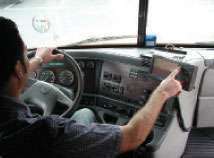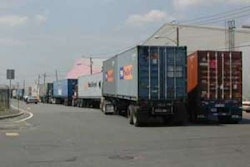Beeline to safety
Mapping, mileage technology extends from office to cab
 Schneider National is implementing Maptuit NaviGo on its Qualcomm MCP200 in-cab computers.
Schneider National is implementing Maptuit NaviGo on its Qualcomm MCP200 in-cab computers.Getting lost is a major source of stress and anxiety for truck drivers, and stress increases the chance they could be involved in an accident. “We definitely know that when drivers are lost, they make bad decisions,” says Don Osterberg, senior vice president of safety at Schneider National.
The Green Bay, Wis.-based company has taken several steps to address the problem of drivers getting lost. Schneider designed a simulation training program for drivers to learn how to get “unlost” while keeping their composure, or “situational awareness.” Experiences in the simulator and in the real world have proven that drivers are less safe when trying to reorient themselves, Osterberg says.
Drivers who are lost make bad decisions.
Schneider recently implemented the Maptuit NaviGo in-cab navigation service that integrates with the company’s operations software and onboard computing and communications system to provide drivers with turn-by-turn spoken directions.
When a truck is in motion, a driver sees an arrow on the screen of his Qualcomm MCP200 in-cab computer that indicates the location of the next turn and distance to it. “We believe that being able to provide better, more granular directions will reduce anxiety,” Osterberg says. “Less anxiety means fewer crashes.”
NaviGo also reduces in-cab distractions such as maps and handwritten directions, as well as looking for road signs. “All of those become tertiary tasks that are not related to driving,” Osterberg says.
Companies that provide mileage, mapping and routing software in the trucking industry all say that fleet customers using their latest navigation products are seeing a return on investment from improved safety and efficiency.
Last year, Rand McNally launched the IntelliRoute Truck Navigation Device (TND), a standalone device that includes all of the legal and physical restrictions for truck routing. To receive the latest route updates, drivers can connect the device to any PC with an Internet connection via the TND Dock. Rand McNally is in the final stages of creating a navigation product that will link the cab to the back office, with the goal of providing connectivity in an innovative and affordable way, says Amy Krouse, director of public relations.
Carriers also can leverage their drivers’ personal laptops to deploy navigation systems. All of ProMiles’ CD-based versions of its mileage and routing software have a truck-specific navigation feature called “Drive Mode.” Drivers will need to purchase a GPS antenna, which can be found at most truckstops.
Drive Mode provides spoken directions with an arrow pointing to the next turn and the distance to it. “We are starting to see more companies willing to buy a license for their back-office work, and then turn around and buy several dozen to a couple hundred licenses for their drivers’ personal laptops to allow them to be more efficient in the cab,” says Chris Lee, vice president of marketing.
Route auditing
Besides offering navigation systems, software providers continue to add more features and services to help fleet managers improve efficiency in the office.
ALK Technologies recently added two new applications, PC Miler Tolls Auditor and PC Miler Tolls Manager, both powered by EBE Technologies. ALK provides the mileage, routing and toll cost data through a Web service, while EBE Technologies provides the workflow analysis tools.
Craig Fiander, ALK’s vice president of marketing, describes the two products as driver performance management tools. The Tolls Manager application automatically will audit the toll costs associated with a planned route versus the actual route a driver took. The Tolls Auditor application can audit the toll costs associated with both the planned and actual route versus the invoices from electronic toll collection and discount programs such as EZ Pass.
ALK is offering two types of pricing models for the two products. One option is to pay a transaction fee for each exception the software generates, such as when a variance occurs in the planned versus actual toll costs per driver, customer, etc. The other option is a monthly service fee based on the number of trucks.
Recent developments by providers of mapping, mileage and routing systems ensure that carriers and drivers have the most accurate up-to-date information necessary to run their businesses safety and efficiently.
In brief
* Pegasus TransTech (www.transflo.com) said that it signed hundreds of new fleet and brokerage customers for Transflo Express truckstop scanning in 2009, the highest rate since launching the product in 2002.
* TransCore (www.transcore.com) announced that Landstar System Inc. completed integration of TransCore’s CarrierWatch monitoring service into its companywide transportation management software system.
* Xata Corp. (www.xata.com) said that Pinnergy Ltd. – a drilling, fluid and oil/gas waste disposal services provider to the energy industry – is installing Xatanet on 78 of its trucks in the Barnett Shale area of Texas.
* EBE Technologies (www.ebe-inc.com) added a Web-based Comprehensive Safety Analysis 2010 scorecard and workflow application to its Ships driver management solution.
* Appian Logistics Software (www.appianlogistics.com), a provider of automated fleet routing and GPS solutions, acquired TruckStops North America from MicroAnalytics.
* Panasonic Computer Solutions introduced the Panasonic Toughbook H1 Field, a rugged handheld tablet computer designed for field sales personnel, supervisors, inspectors, maintenance workers and other mobile professionals.
* Ventech, based in Marl, Germany, has developed and patented a new technology for pneumatic tire maintenance for large and small commercial, municipal and industrial fleets.
Golden Foods targets temps with PAR’s Reefer Watch
PAR Logistics Management Systems announced at the Technology and Maintenance Council’s 2010 Annual Meeting in Tampa, Fla., that Golden Foods has selected its Reefer Watch cold chain management solution. Irvine, Calif.-based Golden Foods is one of the largest diversified suppliers to the foodservice industry, servicing more than 20,000 restaurants on three continents.
The Reefer Watch Refrigerated Trailer Tracking System RT-200 from PAR Logistics provides Golden Foods with the ability to track actual food temperatures consistently in a trailer, instead of air temperature around the cargo. The Reefer Watch system provides real-time monitoring of food product temperature every 15 minutes during transit cycles and also provides immediate alerts to drivers and shipping managers, thanks to a GPS positioning satellite antenna that transmits vital information concerning cargo temperature via alert messages direct to e-mail or text messages to cell phones.
Reefer Watch also provides Web-based utilization, status and history reports, allowing managers to review the entire transit history of a specific shipment of foodservice cargo and verify reefer temperatures during every stage of the shipment.
The RT-200 system is fully compatible with both Carrier and Thermo King refrigeration equipment and is housed in a rugged module that mounts easily to any refrigerated trailer. A driver display monitor with real-time information for four separate temperature zones inside the trailer can be mounted at the left-front corner for easy checks when the vehicle stops.
– Jack Roberts
uDrove now available
uDrove LLC, an Internet Truckstop affiliate, announced a new compliance management tool for the trucking industry. The uDrove tool, in development for the past year, replaces in-cab paperwork and runs on GPS smartphone platforms from BlackBerry, iPhone and Android.
uDrove enables owner-operators, company drivers and fleets to keep an electronic log of hours of service, track mileage for tax purposes, record fuel and business expenses and complete and electronically submit driver vehicle inspection reports and proof-of-delivery documents. The data collected can be exported to various third-party applications and services for tabulating fuel taxes and auditing logbooks. n











